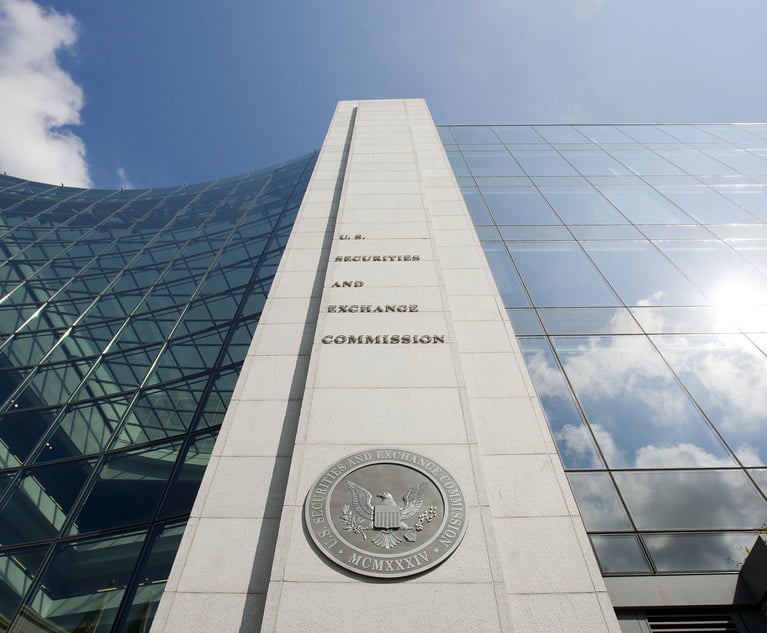Will the Alice ruling change the patentability of software?
Software patentsand questions about whether software should actually be patentable at allhave always been a bone of contention among patent professionals.
April 22, 2014 at 08:00 PM
7 minute read
Software patents—and questions about whether software should actually be patentable at all—have always been a bone of contention among patent professionals. Now the Supreme Court has taken up the issue in Alice Corp. Pty. Ltd. v. CLS Bank International.
The Alice case is the latest in an encouraging trend by the Court to take a more active role in defining and sharpening interpretation of patent law. Overall, this is good news and has the potential to help evolve toward a more predictable patent system.
Alice, in particular, is a somewhat controversial case, and it has court watchers wondering whether and to what degree the ruling might change the definition of software patentability. For some—depending on their point of view—the ruling has the potential to strengthen or weaken the very principle of patent rights.
At RPX, we are fairly agnostic about the case and don't have an opinion on whether the ruling might be good or bad for the patent ecosystem. We do, however, think it is worth considering what impact the decision would have on the actual volume and scope of future litigation. We may soon be using a new definition of patentability for software, so we decided to take a look at the heart of the case to determine just how wide-ranging the Court's ruling could be.
The specific issue before the Court in Alice is whether “claims to computer-implemented inventions—including claims to systems and machines, processes and items of manufacture—are directed to patent-eligible subject matter within the meaning of 35 USC § 101 as interpreted by this Court.”
We wanted to know what impact the answer to this question might have, so we set out to determine just how much litigation actually turns on this definition. To do it, we tasked three RPX experts—two patent attorneys and a patent agent—to analyze a statistically significant cohort of 825 asserted patents. The pool comprised 433 randomly selected patents asserted by operating companies in 2012 and 392 randomly selected patents asserted by non-practicing entities (NPEs) in 2012.
Specifically, the study indicates that claims to computer-implemented inventions were common, with 39 percent of the analyzed patents including at least one claim that should be categorized as such. Further, the study showed that NPEs were more likely than operating companies to assert patents with at least one claim to computer-implemented invention (58 percent of the NPE sample set vs. 21 percent of the operating company sample).
It's worth noting that the question of computer-implemented invention is fairly broad, while the claims in Alice can be seen as somewhat narrower and subject to a petition for covered business methods review, the procedure introduced by the America Invents Act for challenging the validity of certain patents directed to financial products and services. Using this narrower criterion, our experts found that 3 percent of the sample set included at least one claim that should reasonably be categorized as a covered business method.
I'd also point out that our goal in conducting the study was to quantify in general terms the scope of the issue and to determine how broadly litigated software patents actually are. We weren't making any value judgments about the quality or inherent value of claimed inventions. There are many examples of machine-implemented inventions that would seem to be unique, significant and patent-worthy technological advances. Not all software patents are created equal, and that realization is likely to be reflected in any changes that emerge in the wake of the Alice decision.
Readers interested in further discussion of the study findings or in learning more about the methodology we used are invited to view the study at RPXcorp.com.
Software patents—and questions about whether software should actually be patentable at all—have always been a bone of contention among patent professionals. Now the Supreme Court has taken up the issue in Alice Corp. Pty. Ltd. v. CLS Bank International.
The Alice case is the latest in an encouraging trend by the Court to take a more active role in defining and sharpening interpretation of patent law. Overall, this is good news and has the potential to help evolve toward a more predictable patent system.
Alice, in particular, is a somewhat controversial case, and it has court watchers wondering whether and to what degree the ruling might change the definition of software patentability. For some—depending on their point of view—the ruling has the potential to strengthen or weaken the very principle of patent rights.
At RPX, we are fairly agnostic about the case and don't have an opinion on whether the ruling might be good or bad for the patent ecosystem. We do, however, think it is worth considering what impact the decision would have on the actual volume and scope of future litigation. We may soon be using a new definition of patentability for software, so we decided to take a look at the heart of the case to determine just how wide-ranging the Court's ruling could be.
The specific issue before the Court in Alice is whether “claims to computer-implemented inventions—including claims to systems and machines, processes and items of manufacture—are directed to patent-eligible subject matter within the meaning of 35 USC § 101 as interpreted by this Court.”
We wanted to know what impact the answer to this question might have, so we set out to determine just how much litigation actually turns on this definition. To do it, we tasked three RPX experts—two patent attorneys and a patent agent—to analyze a statistically significant cohort of 825 asserted patents. The pool comprised 433 randomly selected patents asserted by operating companies in 2012 and 392 randomly selected patents asserted by non-practicing entities (NPEs) in 2012.
Specifically, the study indicates that claims to computer-implemented inventions were common, with 39 percent of the analyzed patents including at least one claim that should be categorized as such. Further, the study showed that NPEs were more likely than operating companies to assert patents with at least one claim to computer-implemented invention (58 percent of the NPE sample set vs. 21 percent of the operating company sample).
It's worth noting that the question of computer-implemented invention is fairly broad, while the claims in Alice can be seen as somewhat narrower and subject to a petition for covered business methods review, the procedure introduced by the America Invents Act for challenging the validity of certain patents directed to financial products and services. Using this narrower criterion, our experts found that 3 percent of the sample set included at least one claim that should reasonably be categorized as a covered business method.
I'd also point out that our goal in conducting the study was to quantify in general terms the scope of the issue and to determine how broadly litigated software patents actually are. We weren't making any value judgments about the quality or inherent value of claimed inventions. There are many examples of machine-implemented inventions that would seem to be unique, significant and patent-worthy technological advances. Not all software patents are created equal, and that realization is likely to be reflected in any changes that emerge in the wake of the Alice decision.
Readers interested in further discussion of the study findings or in learning more about the methodology we used are invited to view the study at RPXcorp.com.
This content has been archived. It is available through our partners, LexisNexis® and Bloomberg Law.
To view this content, please continue to their sites.
Not a Lexis Subscriber?
Subscribe Now
Not a Bloomberg Law Subscriber?
Subscribe Now
NOT FOR REPRINT
© 2025 ALM Global, LLC, All Rights Reserved. Request academic re-use from www.copyright.com. All other uses, submit a request to [email protected]. For more information visit Asset & Logo Licensing.
You Might Like
View All
Antitrust in Trump 2.0: Expect Gap Filling from State Attorneys General
6 minute read

From Reluctant Lawyer to Legal Trailblazer: Agiloft's GC on Redefining In-House Counsel With Innovation and Tech
7 minute read
Ad Agency Legal Chief Scores $12M Golden Parachute in $13B Sale to Rival
3 minute readTrending Stories
- 1Perkins Coie Lures Former Longtime Wilson Sonsini Tech Transactions Partner
- 2‘The Decision Will Help Others’: NJ Supreme Court Reverses Appellate Div. in OPRA Claim Over Body-Worn Camera Footage
- 3MoFo Associate Sees a Familiar Face During Her First Appellate Argument: Justice Breyer
- 4Antitrust in Trump 2.0: Expect Gap Filling from State Attorneys General
- 5People in the News—Jan. 22, 2025—Knox McLaughlin, Saxton & Stump
Who Got The Work
J. Brugh Lower of Gibbons has entered an appearance for industrial equipment supplier Devco Corporation in a pending trademark infringement lawsuit. The suit, accusing the defendant of selling knock-off Graco products, was filed Dec. 18 in New Jersey District Court by Rivkin Radler on behalf of Graco Inc. and Graco Minnesota. The case, assigned to U.S. District Judge Zahid N. Quraishi, is 3:24-cv-11294, Graco Inc. et al v. Devco Corporation.
Who Got The Work
Rebecca Maller-Stein and Kent A. Yalowitz of Arnold & Porter Kaye Scholer have entered their appearances for Hanaco Venture Capital and its executives, Lior Prosor and David Frankel, in a pending securities lawsuit. The action, filed on Dec. 24 in New York Southern District Court by Zell, Aron & Co. on behalf of Goldeneye Advisors, accuses the defendants of negligently and fraudulently managing the plaintiff's $1 million investment. The case, assigned to U.S. District Judge Vernon S. Broderick, is 1:24-cv-09918, Goldeneye Advisors, LLC v. Hanaco Venture Capital, Ltd. et al.
Who Got The Work
Attorneys from A&O Shearman has stepped in as defense counsel for Toronto-Dominion Bank and other defendants in a pending securities class action. The suit, filed Dec. 11 in New York Southern District Court by Bleichmar Fonti & Auld, accuses the defendants of concealing the bank's 'pervasive' deficiencies in regards to its compliance with the Bank Secrecy Act and the quality of its anti-money laundering controls. The case, assigned to U.S. District Judge Arun Subramanian, is 1:24-cv-09445, Gonzalez v. The Toronto-Dominion Bank et al.
Who Got The Work
Crown Castle International, a Pennsylvania company providing shared communications infrastructure, has turned to Luke D. Wolf of Gordon Rees Scully Mansukhani to fend off a pending breach-of-contract lawsuit. The court action, filed Nov. 25 in Michigan Eastern District Court by Hooper Hathaway PC on behalf of The Town Residences LLC, accuses Crown Castle of failing to transfer approximately $30,000 in utility payments from T-Mobile in breach of a roof-top lease and assignment agreement. The case, assigned to U.S. District Judge Susan K. Declercq, is 2:24-cv-13131, The Town Residences LLC v. T-Mobile US, Inc. et al.
Who Got The Work
Wilfred P. Coronato and Daniel M. Schwartz of McCarter & English have stepped in as defense counsel to Electrolux Home Products Inc. in a pending product liability lawsuit. The court action, filed Nov. 26 in New York Eastern District Court by Poulos Lopiccolo PC and Nagel Rice LLP on behalf of David Stern, alleges that the defendant's refrigerators’ drawers and shelving repeatedly break and fall apart within months after purchase. The case, assigned to U.S. District Judge Joan M. Azrack, is 2:24-cv-08204, Stern v. Electrolux Home Products, Inc.
Featured Firms
Law Offices of Gary Martin Hays & Associates, P.C.
(470) 294-1674
Law Offices of Mark E. Salomone
(857) 444-6468
Smith & Hassler
(713) 739-1250






